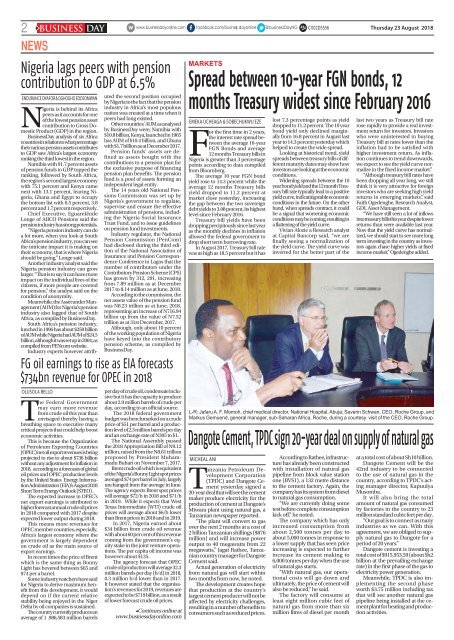BusinessDay 23 Aug 2018
Create successful ePaper yourself
Turn your PDF publications into a flip-book with our unique Google optimized e-Paper software.
2 BUSINESS DAY<br />
C002D5556<br />
Thursday <strong>23</strong> <strong>Aug</strong>ust <strong>2018</strong><br />
NEWS<br />
Nigeria lags peers with pension<br />
contribution to GDP at 6.5%<br />
Endurance Okafor & Oghogho Edosomwan<br />
Nigeria is behind its Africa<br />
peers as it accounts for one<br />
of the lowest pension asset<br />
contribution to Gross Domestic<br />
Product (GDP) in the region.<br />
<strong>BusinessDay</strong> analysis of six Africa<br />
countries in relation to what percentage<br />
their various pension assets contributes<br />
to GDP saw Africa’s largest economy<br />
ranking the third lowest in the region.<br />
Namibia with 91.7 percent assets<br />
of pension funds to GDP topped the<br />
ranking, followed by South Africa,<br />
the region’s second largest economy<br />
with 75.1 percent and Kenya came<br />
next with 13.1 percent, leaving Nigeria,<br />
Ghana and Egypt to occupy<br />
the bottom list with 6.5 percent, 3.8<br />
percent and 1.7 percent respectively.<br />
Chief Executive, Eguarekhide<br />
Longe of AIICO Pensions said the<br />
pension industry has strong potentials.<br />
“Nigeria pension industry can do<br />
a lot more, when you look at South<br />
Africa’s pension industry, you can see<br />
the intricate impact it is making on<br />
their economy, that is where Nigeria<br />
should be going,” Longe said.<br />
Another industry analyst said the<br />
Nigeria pension industry can grow<br />
larger. “That is to say it can have more<br />
impact on the individual lives of the<br />
citizens, if more people are covered<br />
for pension,” the analyst said on the<br />
condition of anonymity.<br />
Meanwhile, the Asset under Management<br />
(AUM) for Nigeria’s pension<br />
industry also lagged that of South<br />
Africa, as compiled by <strong>BusinessDay</strong>.<br />
South Africa’s pension industry,<br />
lunched in 1996 has about $258 billion<br />
of AUM while Nigeria had AUM of $24.5<br />
billion, although it was set up in 2004, as<br />
compiled from PENcom website.<br />
Industry experts however attrib-<br />
FG oil earnings to rise as EIA forecasts<br />
$734bn revenue for OPEC in <strong>2018</strong><br />
Olusola Bello<br />
The Federal Government<br />
may earn more revenue<br />
from crude oil this year than<br />
envisaged thereby having a<br />
breathing space to executive many<br />
critical projects that could help boost<br />
economic activities.<br />
This is because the Organization<br />
of Petroleum Exporting Countries<br />
(OPEC) net oil export revenues is being<br />
projected to rise to about $736 billion<br />
without any adjustment for inflation in<br />
<strong>2018</strong>, according to a forecasts of global<br />
oil prices and OPEC production levels<br />
by the United States Energy Information<br />
Administration (EIA)’s <strong>Aug</strong>ust <strong>2018</strong><br />
Short Term Energy Outlook (STEO) .<br />
The expected increase in OPEC’s<br />
net export earnings is attributed to<br />
higher forecast annual crude oil prices<br />
in <strong>2018</strong> compared with 2017 despite<br />
expected lower output during <strong>2018</strong>.<br />
This means more revenues for<br />
OPEC member countries, especially,<br />
Africa’s largest economy where the<br />
government is largely dependent<br />
on crude oil as the main source of<br />
export earnings.<br />
In recent times the price of Brent<br />
which is the same thing as Bonny<br />
Light has hovered between $65 and<br />
$74 per a barrel.<br />
Some industry watchers have said<br />
for Nigeria to derive maximum benefit<br />
from this development, it would<br />
depend on if the current relative<br />
stability being enjoyed in the Niger<br />
Delta by oil companies is sustained.<br />
The country currently produces an<br />
average of 1 .986,583 million barrels<br />
uted the second position occupied<br />
by Nigeria to the fact that the pension<br />
industry in Africa’s most populous<br />
nation was created at a time when it<br />
peers had long existed.<br />
Other countries’ AUM as analysed<br />
by <strong>BusinessDay</strong> were; Namibia with<br />
$10.8 billion, Kenya, launched in 1965<br />
has AUM of $10.4 billion, and Ghana<br />
with $1.7 billion as at December 2017.<br />
Pension funds’ assets are defined<br />
as assets bought with the<br />
contributions to a pension plan for<br />
the exclusive purpose of financing<br />
pension plan benefits. The pension<br />
fund is a pool of assets forming an<br />
independent legal entity.<br />
The 14 years old National Pensions<br />
Commission was set up by<br />
Nigeria’s government to regulate,<br />
supervise and ensure the effective<br />
administration of pensions, including<br />
the Nigeria Social Insurance<br />
Trust Fund, and to issue guidelines<br />
on pension fund investments.<br />
Industry regulator, the National<br />
Pension Commission (PenCom)<br />
had disclosed during the third edition<br />
of the National Association of<br />
Insurance and Pension Correspondence<br />
Conference in Lagos that the<br />
number of contributors under the<br />
Contributory Pension Scheme (CPS)<br />
has grown by 312, 291, increasing<br />
from 7.89 million as at December<br />
2017 to 8.14 million as at June, <strong>2018</strong>.<br />
According to the commission, the<br />
net assets value of the pension fund<br />
was N8.<strong>23</strong> trillion as at June, <strong>2018</strong>,<br />
representing an increase of N716.94<br />
billion up from the value of N7.52<br />
trillion as at 31st December, 2017.<br />
Although, only about 10 percent<br />
of the working population of Nigeria<br />
have keyed into the contributory<br />
pension scheme, as compiled by<br />
<strong>BusinessDay</strong>.<br />
per day of crude oil, condensate inclusive<br />
but it has the capacity to produce<br />
about 2.9 million barrels of crude per<br />
day, according to an official source.<br />
The <strong>2018</strong> federal government<br />
budget was benchmarked on a crude<br />
price of $51 per barrel and a production<br />
level of 2.3 million barrels per day<br />
and an exchange rate of N305 to $1.<br />
The National Assembly passed<br />
the <strong>2018</strong> Appropriation Bill of N9.12<br />
trillion, raised from the N8.61 trillion<br />
proposed by President Muhammadu<br />
Buhari on November 7, 2017.<br />
Brent crude oil which is equivalent<br />
of the Nigeria’s Bonny Light spot prices<br />
averaged $74 per barrel in July, largely<br />
unchanged from the average in June.<br />
The agency expects Brent spot prices<br />
will average $72/b in <strong>2018</strong> and $71/b<br />
in 2019. While it expects that West<br />
Texas Intermediate (WTI) crude oil<br />
prices will average about $6/b lower<br />
than Brent prices in <strong>2018</strong> and in 2019.<br />
In 2017, Nigeria earned about<br />
$34 billion from crude oil revenue<br />
with about 60 per cent of this revenue<br />
coming from the government’s equity<br />
stake in the joint venture operations.<br />
The per capita oil income was<br />
however about $135.<br />
The agency forecast that OPEC<br />
crude oil production will average 32.3<br />
million barrels per day (b/d) in <strong>2018</strong>,<br />
0.3 million b/d lower than in 2017.<br />
It however stated that the organisation’s<br />
revenues for 2019, revenues are<br />
expected to be $719 billion, as a result<br />
of lower forecast crude oil prices.<br />
•Continues online at<br />
www.businessdayonline.com<br />
MARKETS<br />
Spread between 10-year FGN bonds, 12<br />
months Treasury widest since February 2016<br />
Emeka Ucheaga & Sobechukwu Eze<br />
For the first time in 2 years,<br />
the interest rate spread between<br />
the average 10-year<br />
FGN Bonds and average<br />
12 months Treasury bills in<br />
Nigeria is greater than 3 percentage<br />
points according to data compiled<br />
from Bloomberg.<br />
The average 10 year FGN bond<br />
yield rose to 14.3 percent while the<br />
average 12 months Treasury bills<br />
yield dropped to 11.2 percent at<br />
market close yesterday, increasing<br />
the gap between the two sovereign<br />
debt yields to 3.08 percent, its highest<br />
level since February 2016.<br />
Treasury bill yields have been<br />
dropping precipitously since last year<br />
as the monthly declines in inflation<br />
allowed the federal government to<br />
drop short term borrowing rate.<br />
In <strong>Aug</strong>ust 2017, Treasury bill rate<br />
was as high as 18.5 percent but it has<br />
L-R: Jafaru A. F. Momoh, chief medical director, National Hospital, Abuja; Severin Schwan, CEO, Roche Group, and<br />
Markus Gemuend, general manager, sub-Saharan Africa, Roche, during a courtesy visit of the CEO, Roche Group.<br />
Dangote Cement, TPDC sign 20-year deal on supply of natural gas<br />
MICHEAL ANI<br />
Tanzania Petroleum Development<br />
Corporation<br />
(TPDC) and Dangote Cement<br />
yesterday signed a<br />
20-year deal that will see the cement<br />
maker produce electricity for the<br />
production of cement at Dangote’s<br />
Mtwara plant using natural gas, a<br />
Tanzanian newspaper reported.<br />
“The plant will convert to gas<br />
over the next 2 months at a cost of<br />
2 billion Tanzanian shillings ($876<br />
million) and will increase power<br />
output to 40 megawatts from 22<br />
megawatts,” Jagat Rathee, Tanzanian<br />
country manager for Dangote<br />
Cement said.<br />
Actual generation of electricity<br />
from natural gas will start within<br />
two months from now, he noted.<br />
The development creates hope<br />
that production at the country’s<br />
largest cement producer will not be<br />
affected by electricity challenges,<br />
resulting in a number of benefits to<br />
consumers such as reduced prices.<br />
lost 7.3 percentage points as yield<br />
dropped to 11.2 percent. The 10 year<br />
bond yield only declined marginally<br />
from 16.8 percent in <strong>Aug</strong>ust last<br />
year to 14.3 percent yesterday which<br />
helped to create the wide spread.<br />
Looking at historical trend, yield<br />
spreads between treasury bills of different<br />
maturity dates may show how<br />
investors are looking at the economic<br />
conditions.<br />
Widening spreads between the 10<br />
year bond yield and the 12 month Treasury<br />
bill rate typically lead to a positive<br />
yield curve, indicating stable economic<br />
conditions in the future. On the other<br />
hand, when spreads contract, it could<br />
be a signal that worsening economic<br />
conditions may be coming, resulting in<br />
a flattening of the yield curve.<br />
Vivian Alozie a Research analyst<br />
at Capital Bancorp said, “we are<br />
finally seeing a normalization of<br />
the yield curve. The yield curve was<br />
inverted for the better part of the<br />
According to Rathee, infrastructure<br />
has already been constructed<br />
with installation of natural gas<br />
pipeline from block value station<br />
one (BVS1), a 132 metre distance<br />
to the cement factory. Again, the<br />
company has its system from diesel<br />
to natural gas consumption.<br />
“We are currently doing some<br />
test before complete consumption<br />
kick off,” he noted.<br />
The company which has only<br />
increased consumption from<br />
about 2,500 tonnes per day to<br />
about 5,000 tonnes in response to<br />
a lower supply that has seen price<br />
increasing is expected to further<br />
increase its cement making to<br />
6,000 tonnes per day when the use<br />
of natural gas starts.<br />
“With natural gas, our operational<br />
costs will go down and<br />
ultimately, the price of cement will<br />
also be reduced,” he said.<br />
The factory will consume at<br />
least eight million cubic feet of<br />
natural gas from more than six<br />
million litres of diesel per month<br />
last two years as Treasury bill rate<br />
rose rapidly to provide a real investment<br />
return for investors. Investors<br />
who were uninterested in buying<br />
Treasury bill at rates lower than the<br />
inflation had to be satisfied with<br />
higher investment return. As inflation<br />
continues to trend downwards,<br />
we expect to see the yield curve normalize<br />
in the fixed income market.”<br />
“Although treasury bill rates have<br />
been dropping all year long, we still<br />
think it is very attractive for foreign<br />
investors who are seeking high yield<br />
returns in emerging markets”, said<br />
Faith Ogedengbe, Research Analyst,<br />
GDL Asset Management.<br />
“We have still seen a lot of inflows<br />
into treasury bills this year despite lower<br />
returns than were available last year.<br />
Now that the yield curve has normalized,<br />
we should start to see more long<br />
term investing in the country as investors<br />
again chase higher yields at fixed<br />
income market,” Ogedengbe added.<br />
at a total cost of about Sh10 billion.<br />
Dangote Cement will be the<br />
42nd industry to be connected<br />
to the use of natural gas in the<br />
country, according to TPDC’s acting<br />
manager director, Kapuulya<br />
Musomba.<br />
It will also bring the total<br />
amount of natural gas consumed<br />
by factories in the country to <strong>23</strong><br />
million standard cubic feet per day.<br />
“Our goal is to connect as many<br />
industries as we can. With this<br />
agreement, we are obliged to supply<br />
natural gas to Dangote for a<br />
period of 20 years.”<br />
Dangote cement is investing a<br />
total cost of $915,953.59 (about Sh2<br />
billion at the prevailing exchange<br />
rate) in the first phase of the gas to<br />
electricity power generation.<br />
Meanwhile, TPDC is also implementing<br />
the second phase<br />
worth $3.75 million including tax<br />
that will see another natural gas<br />
pipeline being installed at the cement<br />
plant for heating and production<br />
activities.

















